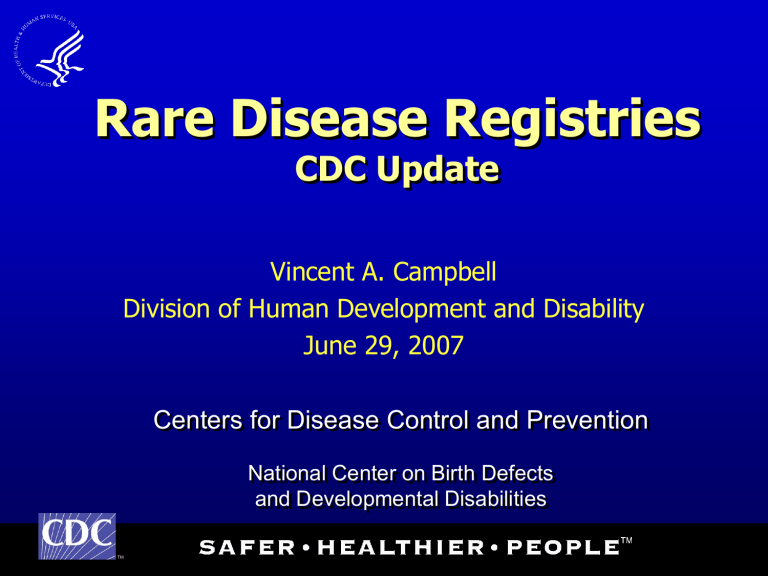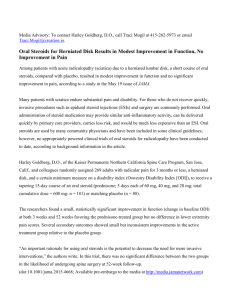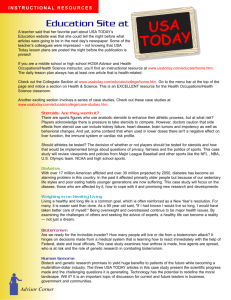Rare Disease Registries CDC Update

Rare Disease Registries
CDC Update
TM
Vincent A. Campbell
Division of Human Development and Disability
June 29, 2007
Centers for Disease Control and Prevention
National Center on Birth Defects and Developmental Disabilities
Registries in NCBDDD
Operational Registry - Hemophilia
Purpose – Surveillance of blood safety and joint disease
~95 clinics using electronic medical record (EMR);
~40 are in process of installing
~25,000 patients seen in these clinics (app. 70% of affected population); ~ 18,000 included in the
EMR
Data maintained at CDC – CDC has access to surveillance data
Funding – HRSA, CDC
TM
Registries in NCBDDD
Registry Planning & Pilot – Spina Bifida
Purpose – Improving care; establishing a basis for research
~ 150 clinics (?); loose affiliation with SBA
Affected population, ~70,000 – 130,000 (?)
Development being supervised by SBA Professional
Advisory Council with involvement of CDC National
Center for Public Health Informatics and
NCBDDD/DHDD
Funding – HRSA, CDC
TM
Registries in NCBDDD
Early Planning – Duchenne Muscular Dystrophy
Purpose – Differs among stakeholders –
Improving care, identifying candidates for clinical trials . . .
Surveillance data elements not identified
Potential data sources – clinics, other
2 projects planned
◊ Link existing databases
◊ Develop Single Gene Information System
Funding - ?
TM
MD STARnet
5 Sites – AZ, CO, GA, IA, western NY
Cases abstracted-716 (data as of May 2007)
◊ 422 definite, 54 probable, 82 possible
2007-continue to abstract new cases and conduct CATI interview with parents
2006-”The Muscular Dystrophy Surveillance Tracking and Research Network (MD STARnet): Surveillance
Methodology published
Research Questions/Activities identified
4 poster presentations
TM
MD STARnet Research Questions
Prevalence and trends (including demographics)
Distribution of genotypes and mutations
Health/other outcomes by genotypes/mutations
Diagnostic delay
Treatments and therapeutical interventions
Medical/non-medical complications
Clinical course/progression
TM
Diagnostic Delay
Presented at American Academy of Neurology-April 2007
CONCLUSIONS
• The diagnosis of DMD in the
USA remains delayed due to failure in early CK screening.
• A late diagnosis has implications for both child and family.
• Steps should be taken to educate all providers involved in the care of young children on the common DMD presentations and the importance of early CK screening
From Ciafaloni, Pandya, Fox, Matthews,
Mathews, Miller, and MD STARnet
TM
MD STARnet - Steroid Use
PRELIMINARY DATA
476 cases of which 272 did not use steroids
159 used steroids for more than 1 year and 45 used steroids for 1 year or less
Of the 476 cases 219 have ceased ambulation
◊ Patients who had used steroids for more than 1 year had a larger proportion still ambulating compared with those who had not used steroids at all (F=7.12, p =0.009)
◊ Statistical significant difference in the mean age that ambulation ceased between those never on steroids and those on steroids for at least 1 year (F=5.60, p =0.0043)
– Those on steroids for less than 1 year neither saw a significant benefit nor decline
TM
PRELIMINARY ANALYSIS
Annual Proportion of MD Cases on
Steroids (1987-2004)
20
18
16
14
12
10
8
6
4
2
0
1987 1988 1989 1990 1991 1992 1993 1994 1995 1996 1997 1998 1999 2000 2001 2002 2003 2004
Year
From David Matthews
TM


